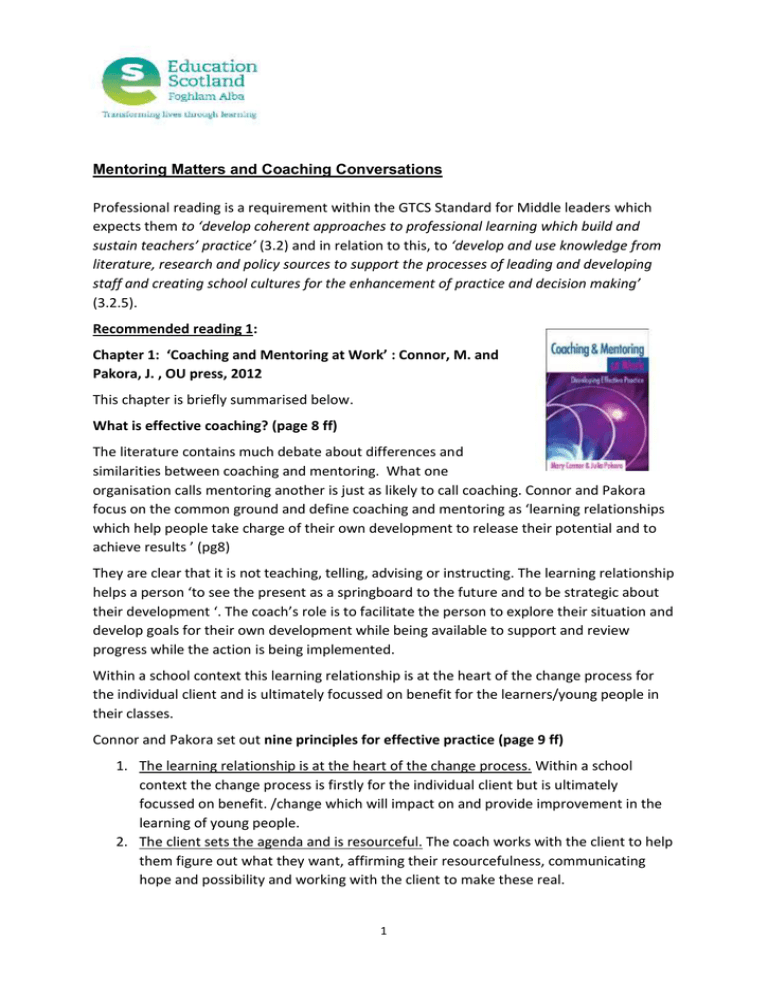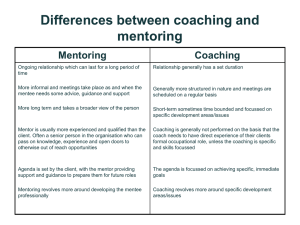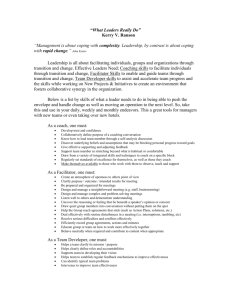Mentoring Matters and Coaching Conversations
advertisement

Mentoring Matters and Coaching Conversations Professional reading is a requirement within the GTCS Standard for Middle leaders which expects them to ‘develop coherent approaches to professional learning which build and sustain teachers’ practice’ (3.2) and in relation to this, to ‘develop and use knowledge from literature, research and policy sources to support the processes of leading and developing staff and creating school cultures for the enhancement of practice and decision making’ (3.2.5). Recommended reading 1: Chapter 1: ‘Coaching and Mentoring at Work’ : Connor, M. and Pakora, J. , OU press, 2012 This chapter is briefly summarised below. What is effective coaching? (page 8 ff) The literature contains much debate about differences and similarities between coaching and mentoring. What one organisation calls mentoring another is just as likely to call coaching. Connor and Pakora focus on the common ground and define coaching and mentoring as ‘learning relationships which help people take charge of their own development to release their potential and to achieve results ’ (pg8) They are clear that it is not teaching, telling, advising or instructing. The learning relationship helps a person ‘to see the present as a springboard to the future and to be strategic about their development ‘. The coach’s role is to facilitate the person to explore their situation and develop goals for their own development while being available to support and review progress while the action is being implemented. Within a school context this learning relationship is at the heart of the change process for the individual client and is ultimately focussed on benefit for the learners/young people in their classes. Connor and Pakora set out nine principles for effective practice (page 9 ff) 1. The learning relationship is at the heart of the change process. Within a school context the change process is firstly for the individual client but is ultimately focussed on benefit. /change which will impact on and provide improvement in the learning of young people. 2. The client sets the agenda and is resourceful. The coach works with the client to help them figure out what they want, affirming their resourcefulness, communicating hope and possibility and working with the client to make these real. 1 3. The coach facilitates learning and development. Development involves the client integrating their learning into their everyday working and ultimately to their way of being. 4. The context for this learning relationship is work. The focus for the learning relationship is the client’s present and future experiences, problems, opportunities and development. The best results are produced when there is a balance between developing strengths and resources and addressing areas for development. 5. The outcome is change and action. The client achieves a change which they care about and this change makes a positive difference to their working life. A tiny change for one client may be just as transformative as a change of job or remit for another. Change is hard work, change provokes resistance. Resistance should be seen by the coach as a sign that the learning dialogue is on track and is getting at important issues. A skilled coach uses resistance to help the client examine their own values and goals and help them towards finding out what will help or prevent them making changes for the better. 6. The approach or model provides movement and direction …….a map for the journey, not a full description of the landscape of the journey but reference points and a sense of direction. It should help if either party gets lost and be used with a light touch or even set aside if it is hindering progress. 7. The skills develop insight release potential and deliver results. The coach communicates their belief in and valuing of the client and balances support and challenge, reflection and action to keep the client moving towards the goal. 8. The qualities of the coach affirm enable and sustain the client. They have the wisdom to make sound judgements about what they see, hear and experience in the learning relationship. They model a way of being which is based on caring, valuing, respecting and empathising with the client, a way that is both human and professional. Learning is achieved, not from the coach but with them and through them and this may be the most powerful learning of all. 9. Ethical practice safeguards and enhances coaching. There should be a clear understanding of what the learning relationship is and is not. There should be clear expectations and on-going review of the working agreement. Ethical coaching is informed by legal requirements and professional codes of practice. Working within these agreed limits enables the client to feel secure e.g in relation to confidentiality or conflicts of interest. 2




